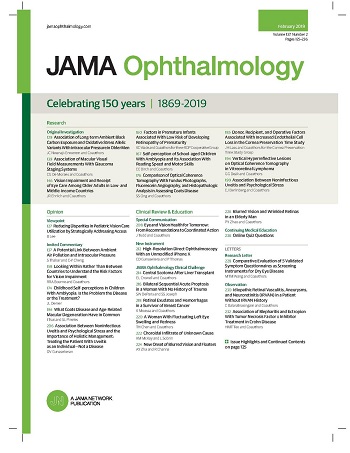类固醇和交联治疗溃疡:SCUT II随机临床试验。
IF 9.2
1区 医学
Q1 OPHTHALMOLOGY
引用次数: 0
摘要
辅助外用皮质类固醇和/或角膜交联(CXL)有可能改善细菌性角膜炎的预后。目的探讨在外用抗生素的基础上,应用核黄素辅助外用二氟泼尼酯和CXL的疗效。设计、环境和参与者:这是一项由美国国立卫生研究院(NIH)资助的假性安慰剂对照试验,将参与者随机分配到局部莫西沙星0.5% +局部安慰剂+假CXL,与局部莫西沙星0.5% +二氟泼酸0.05% +假CXL,与局部莫西沙星0.5% +二氟泼酸0.05% +假CXL。在2020年9月至2023年10月期间,对印度Aravind眼科医院和佛罗里达州迈阿密大学巴斯科姆帕尔默眼科研究所诊所的参与者进行了纳入筛选。纳入的参与者有涂片和/或培养阳性的细菌性角膜溃疡,Snellen视力为20/40或更差。主要结果和测量主要结果为6个月时的最佳眼镜矫正视力(BSCVA)。结果在1992名涂片阳性细菌性角膜溃疡患者中,280名(14%;平均[SD]年龄51岁;182名男性[65%])入组。在控制基线后,辅助外用类固醇与安慰剂的6个月VA无差异(-0.04;95% CI, -0.18 ~ 0.09;P = .58),或者与单独使用局部类固醇相比,使用辅助CXL和局部类固醇(0.04;95% CI, -0.09 ~ 0.17;p = .62)。在控制基线浸润和/或疤痕大小后6个月,辅助外用皮质类固醇也没有改善疤痕大小(-0.22;95% CI, -0.53 ~ 0.10;p = .65)。在控制基线浸润和/或疤痕大小后,CXL加皮质类固醇与单独使用类固醇相比增加了疤痕大小(0.56;95% ci, 0.20-0.92;p = .02)。为0.78 (95% CI, 0.27-2.24;P = 0.65)是早期类固醇治疗组穿孔或需要治疗性穿透性角膜移植术(TPK)风险的两倍,为0.48 (95% CI, 0.14-1.67;P = 0.25)是控制渗透深度后CXL臂穿孔危险或TPK需求的两倍。结论和相关性这项随机临床试验的结果显示,辅助外用皮质类固醇并不优于安慰剂,而辅助CXL会增加疤痕大小,这表明这些替代疗法,平均而言,可能并不优于单独外用抗生素治疗细菌性角膜炎。临床试验注册号:NCT04097730。本文章由计算机程序翻译,如有差异,请以英文原文为准。
Steroids and Cross-Linking for Ulcer Treatment: The SCUT II Randomized Clinical Trial.
Importance
Adjunctive topical corticosteroids and/or corneal cross-linking (CXL) have the potential to improve outcomes in bacterial keratitis.
Objective
To determine the benefit of adjunctive topical difluprednate and CXL with riboflavin in addition to topical antibiotics.
Design, Setting, and Participants
This was a National Institutes of Health (NIH)-funded, sham, placebo-controlled trial randomizing participants to topical moxifloxacin, 0.5%, plus topical placebo plus sham CXL, vs topical moxifloxacin, 0.5%, plus difluprednate, 0.05%, plus sham CXL, vs topical moxifloxacin, 0.5%, plus difluprednate, 0.05%, plus CXL. Between September 2020 and October 2023, participants in clinics at the Aravind Eye Hospitals in India and Bascom Palmer Eye Institute, University of Miami, in Miami, Florida, were screened for inclusion. Included participants had smear- and/or culture-positive bacterial corneal ulcers with Snellen visual acuity of 20/40 or worse.
Main Outcomes and Measures
The primary outcome was logMAR best spectacle-corrected visual acuity (BSCVA) at 6 months.
Results
Of the 1992 participants with smear-positive bacterial corneal ulcers screened, 280 participants (14%; mean [SD] age, 51 [16] years; 182 male [65%]) were enrolled. After controlling for baseline, there was no difference in 6-month VA with adjunctive topical steroids vs placebo (-0.04; 95% CI, -0.18 to 0.09; P = .58) or with adjunctive CXL and topical steroids vs topical steroids alone (0.04; 95% CI, -0.09 to 0.17; P = .62). Adjunctive topical corticosteroids also did not improve scar size at 6 months after controlling for baseline infiltrate and/or scar size (-0.22; 95% CI, -0.53 to 0.10; P = .65). CXL plus corticosteroids increased scar size compared with steroids alone after controlling for baseline infiltrate and/or scar size (0.56; 95% CI, 0.20-0.92; P = .02). There was 0.78 (95% CI, 0.27-2.24; P = .65) times the hazard of perforation or the need for therapeutic penetrating keratoplasty (TPK) in the early-steroid arm and 0.48 (95% CI, 0.14-1.67; P = .25) times the hazard of perforation or the need for TPK in the CXL arm after controlling for infiltrate depth.
Conclusions and Relevance
Results of this randomized clinical trial reveal that adjunctive topical corticosteroids were not superior to placebo, and adjunctive CXL had increased scar size, suggesting that these alternative therapies, on average, may not be superior to topical antibiotics alone for treatment of bacterial keratitis.
Trial Registration
ClinicalTrials.gov Identifier: NCT04097730.
求助全文
通过发布文献求助,成功后即可免费获取论文全文。
去求助
来源期刊

JAMA ophthalmology
OPHTHALMOLOGY-
CiteScore
13.20
自引率
3.70%
发文量
340
期刊介绍:
JAMA Ophthalmology, with a rich history of continuous publication since 1869, stands as a distinguished international, peer-reviewed journal dedicated to ophthalmology and visual science. In 2019, the journal proudly commemorated 150 years of uninterrupted service to the field. As a member of the esteemed JAMA Network, a consortium renowned for its peer-reviewed general medical and specialty publications, JAMA Ophthalmology upholds the highest standards of excellence in disseminating cutting-edge research and insights. Join us in celebrating our legacy and advancing the frontiers of ophthalmology and visual science.
 求助内容:
求助内容: 应助结果提醒方式:
应助结果提醒方式:


